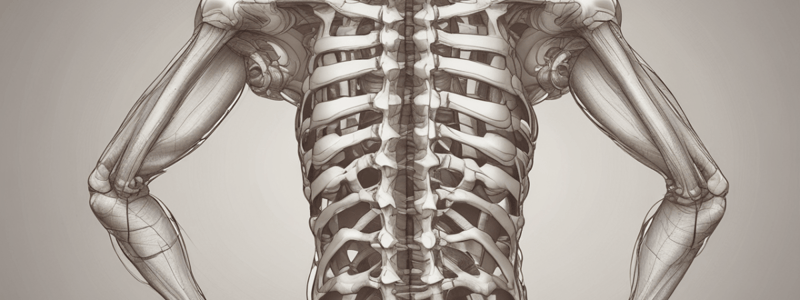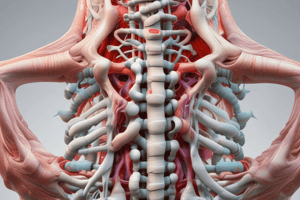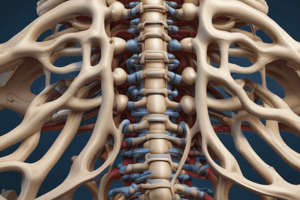Podcast
Questions and Answers
What forms a passive segment in the vertical plane?
What forms a passive segment in the vertical plane?
- The intervertebral disc
- The facet joints
- The vertebra itself (correct)
- The ligamentum flavum
What is responsible for the movements of the vertebral spine?
What is responsible for the movements of the vertebral spine?
- The ligamentum flavum
- The mobile segment (correct)
- The intervertebral disc
- The facet joints
What is the function of the pedicles?
What is the function of the pedicles?
- To act as a fulcrum
- To form a passive segment
- To form a mobile segment
- To form a functional link between the anterior and posterior pillars (correct)
What is the role of the intervertebral disc in the vertebral motion segment?
What is the role of the intervertebral disc in the vertebral motion segment?
What are the degrees of freedom (DoF) in a joint?
What are the degrees of freedom (DoF) in a joint?
What type of movement is possible at the interbody joints?
What type of movement is possible at the interbody joints?
What is the role of the paravertebral muscles in the vertebral motion segment?
What is the role of the paravertebral muscles in the vertebral motion segment?
What type of stress is the vertebral column subjected to during normal functional activities?
What type of stress is the vertebral column subjected to during normal functional activities?
What is the reason for the expression of fluid from the nucleus pulposus and the annulus fibrosus?
What is the reason for the expression of fluid from the nucleus pulposus and the annulus fibrosus?
What is the structure of each vertebra?
What is the structure of each vertebra?
What happens when the compressive forces are decreased?
What happens when the compressive forces are decreased?
Why is a person taller in the morning than in the evening?
Why is a person taller in the morning than in the evening?
What is the stiffness of the vertebral column?
What is the stiffness of the vertebral column?
What determines the vertebral column's ability to resist loads?
What determines the vertebral column's ability to resist loads?
During forward flexion, which structures are subjected to tension?
During forward flexion, which structures are subjected to tension?
What provides stability in flexion?
What provides stability in flexion?
During extension, which structures are subjected to tension?
During extension, which structures are subjected to tension?
What provides resistance to extension?
What provides resistance to extension?
During lateral bending, which side of the disk is compressed?
During lateral bending, which side of the disk is compressed?
What helps to provide stability during lateral bending?
What helps to provide stability during lateral bending?
What results from prolonged forces with creep loading?
What results from prolonged forces with creep loading?
What happens to the load on the spine when there are prolonged compressive forces?
What happens to the load on the spine when there are prolonged compressive forces?
What is the result of the increased load on the annulus fibrosus?
What is the result of the increased load on the annulus fibrosus?
What is the effect of creep on the supporting structures?
What is the effect of creep on the supporting structures?
What type of forces are created during axial rotation?
What type of forces are created during axial rotation?
Where is the highest torsional stiffness found?
Where is the highest torsional stiffness found?
What structures provide torsional stiffness?
What structures provide torsional stiffness?
How do the annulus fibrosus fibers resist rotation?
How do the annulus fibrosus fibers resist rotation?
What is the most effective structure in the lumbar region for resisting torsion?
What is the most effective structure in the lumbar region for resisting torsion?
What increases the risk of rupture of the disk fibers?
What increases the risk of rupture of the disk fibers?
What is the result of the coupled motions?
What is the result of the coupled motions?
Flashcards are hidden until you start studying
Study Notes
Motion and Mobility Segment
- The vertebral column consists of passive segments (bony and ligamentous structures) and active segments (mobility features).
- The mobile segment includes intervertebral discs, intervertebral foramina, facet joints, ligamentum flavum, and interspinous ligaments.
- Mobility of this active segment enables vertebral spine movements.
- Functional link between anterior and posterior pillars is formed by pedicles.
Structural Mechanics
- Each vertebra has a trabecular structure forming a first-class lever where articular processes act as the fulcrum.
- Axial compression forces are cushioned directly by intervertebral discs and indirectly by paravertebral muscles.
- Overall cushioning effects combine both passive and active mechanisms.
Available Movements
- Interbody joints permit multiple movements:
- Gliding: movements include anterior-posterior, medial-lateral, and torsional.
- Distraction and compression.
- Rotation in anterior-posterior and lateral directions.
- Mobility includes three translational movements and three angular movements, summing to six degrees of freedom (DoF).
Stability of the Spine
- The stiffness of the vertebral column relates to its capacity to resist loads like axial compression, tension, bending, torsion, and shear stress during various activities.
- Resistance to these forces varies by spinal region and is influenced by loading type, duration, age, posture, and structural condition.
Axial Compression Dynamics
- Caused by gravity, ground reaction forces, and muscle contractions.
- Sustained compressive loading leads to loss of fluid from the nucleus pulposus and annulus fibrosus.
- Fluid reabsorption occurs when compressive forces diminish, explaining height changes from morning to evening.
Effects of Bending
- Forward flexion results in anterior structures being tensioned while the posterior structures face compression.
- Collagen fibers in the posterior anulus fibrosus play a role in providing flexibility and stability during motion.
- In lateral bending, compression occurs on the ipsilateral disc side, while the contralateral side provides resistance against extreme motion.
Prolonged Mechanical Forces
- Prolonged compressive forces can shift loads from the nucleus pulposus to the annulus fibrosus, risking buckling or prolapse.
- Creep leads to elongation of spinal structures, diminishing stability and increasing injury risk.
Torsion and Its Effects
- Torsional forces arise during axial rotation and are highest at the thoracolumbar junction.
- Torsion resistance is mainly provided by the outer layers of vertebral bodies, intervertebral discs, and facet joint orientations.
- The lumbar region plays a crucial role in resisting torsion but is at heightened risk when combined with heavy axial compression and bending forces.
Studying That Suits You
Use AI to generate personalized quizzes and flashcards to suit your learning preferences.




